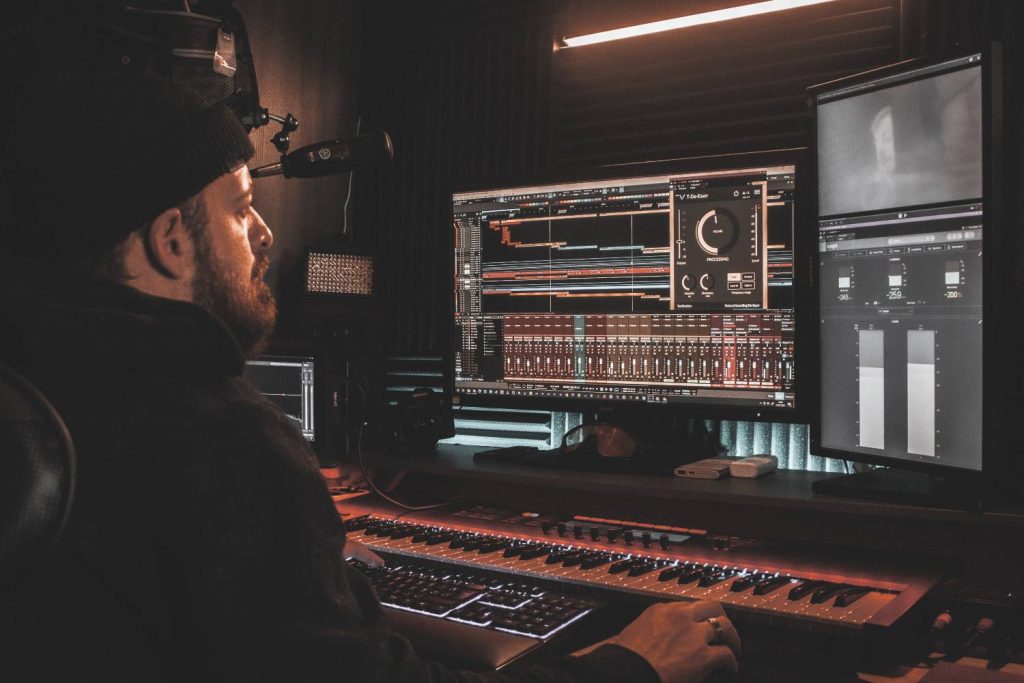A simple enough contraption to prevent breath, wind and plosives from a recording, a pop filter does just what its name suggests: it filters out pops from recording.
A pop filter is one of those ingenious tools that you may not notice their impact until you’re stuck without one. Easily made at home with a material like tights or stockings, or anything acoustically transparent really, and something like a metal coat hanger, it’s a filter that absorbs the energy of a plosive; a speech sound categorised as a sound with a sudden burst of air. Plosives include ‘p’, ‘k’, ‘t’ and ‘b’ sounds to name a few. While traditionally used for vocals, they’re equally helpful for other sources with a sharp transient like a kick drum (where air is literally pushed out of a hole in the bass drum’s resonant head), as well as location recording outside an insulated space.
Microphone pop filter
A pop filter, also known as a pop screen or pop shield, serves to prevent the sudden impact of a rush of breath on a microphone’s diaphragm that results in pops or crackles. Made from what is traditionally a circular design, the filter is attached to a microphone stand with an arm, though the windscreen (both the metal grille and the foam insert) act as a pop filter as well.
Read all the latest features, columns and more here.
Metal pop filters are available as well, and they allow sound to pass through a metal grille instead of a material filter. In a professional studio setting, pop filters also serve to filter out saliva from reaching the microphone’s capsule. Pop filters are traditionally placed an inch or two from the microphone, any further away causing a less directional recording from the microphone, and any closer, you run the risk of the vibrations captured by the filter rattling into the microphone regardless.
What does a pop filter do
Pop filters and wind screens are a great way to prevent distortion and clipping from larger transients. Something like a T-shirt over a phone serves to filter out excessive noise, i.e. when a full band is demoing in a rehearsal room.
Another handy tip for consistent, balanced recording is to use them to assist a singer in maintaining distance from a microphone. Performing music can be expressive and dynamic, and a pop filter positioned an inch or two from the microphone can be used as a point of reference. This assists the singer to maintain the same distance from the mic throughout a recording session, ultimately leading to a more consistent recording.
DIY solutions to great recordings
A sock or pair of tights is a great makeshift windscreen as well, serving to both filter out pops and wind, as well as protect the microphone capsule. For capturing high SPL sounds in a studio, like a kick drum or snare, signals can be protected from accidental clipping or distortion without overtly affecting the recorded sound.
Recording for film
In film, there’s additional windscreens for more extreme wind, rain and noise. Colloquially known as a “deadcat”, windscreens intended for film vary in sizes depending on the size of your microphone. For a deadcat, acoustic energy from wind and rain, fizzles out into the longer hair and fur of the filter, with only the strongest sounds, usually the stuff you’re trying to capture, ends up being captured by the microphone.
All in all, a pop filter is a handy tool for just about everyone working in audio. Whether controlling a singer or filtering out rain and wind, the pop filter’s design hasn’t really had much need to change or evolve. Available with either a material or metal shield, a pop filter prevents extraneous noise from affecting an otherwise great recording.
Plosives from a singer, or exasperated sounds from a dynamic podcast guest can be prevented by the simple contraption that is the pop filter. The design can be replicated by covering a phone or recorder with any material you might have available, like a shirt, similar to how a microphone for foley or film dialogue is covered by a “deadcat” and excessive noise fizzles away before signal reaches the microphone itself.
A tool for maintaining consistent audio both mechanically, physically and sonically, the pop filter is a hugely handy tool to have in the engineer’s toolbox.
Read more microphone recording at Shure.







